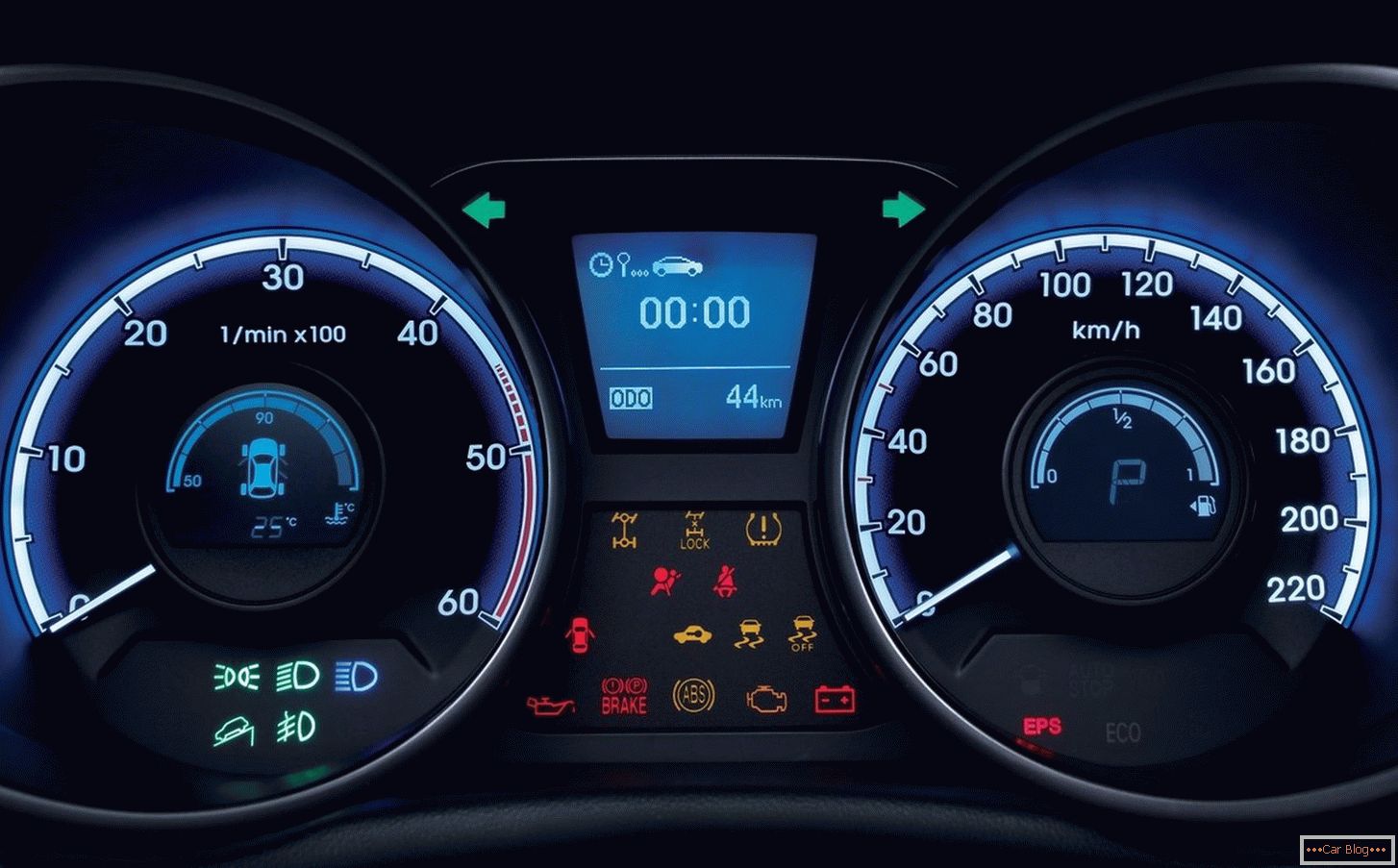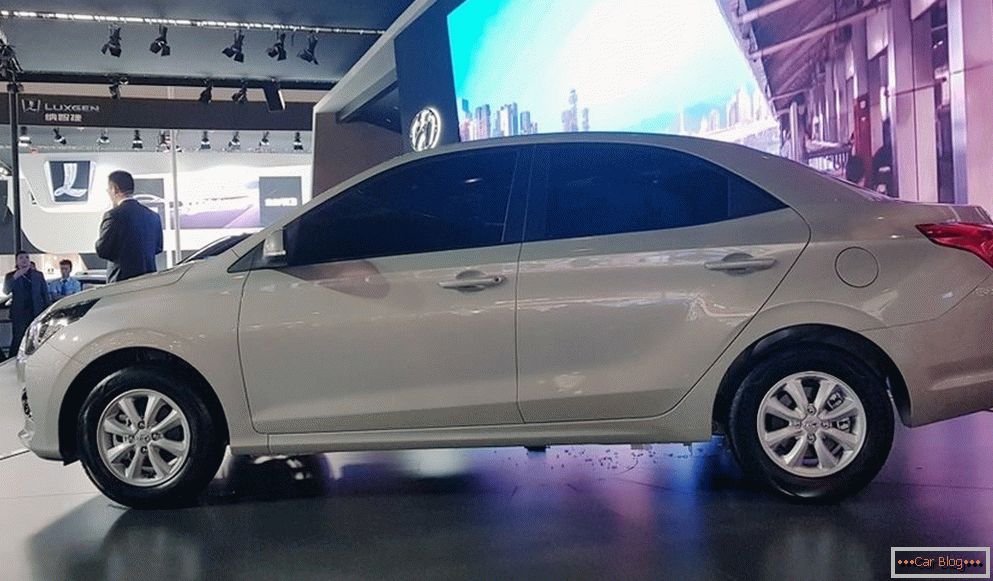>
Even the most disciplined car owner is not protected from damage to the paintwork of his car. And if for beginners the flawless appearance of the car usually comes first, then experienced drivers are well aware that it is worth leaving the scratched section unprocessed, how the corrosion virus will take it, which in a short time can spread to a fairly extensive area. Therefore, bringing to normal paintwork is an event that is desirable to perform as soon as possible. In this regard, there are several options available for solving a problem - contact an auto repair station that will cost a lot of money, using the “garage” level service is cheaper, but not so qualitatively. Finally, you can tackle body parts yourself. In this case, you will have to spend money on the purchase of appropriate equipment, but if you consider that painting will have to be done for almost the entire life of the car, then this method can be called the most preferable. The main problem that will have to be solved when buying such equipment is which compressor is needed for painting cars, since the modern market is literally overflowing with models of different designs and performance. Coverage of this particular issue and will be devoted to this material.
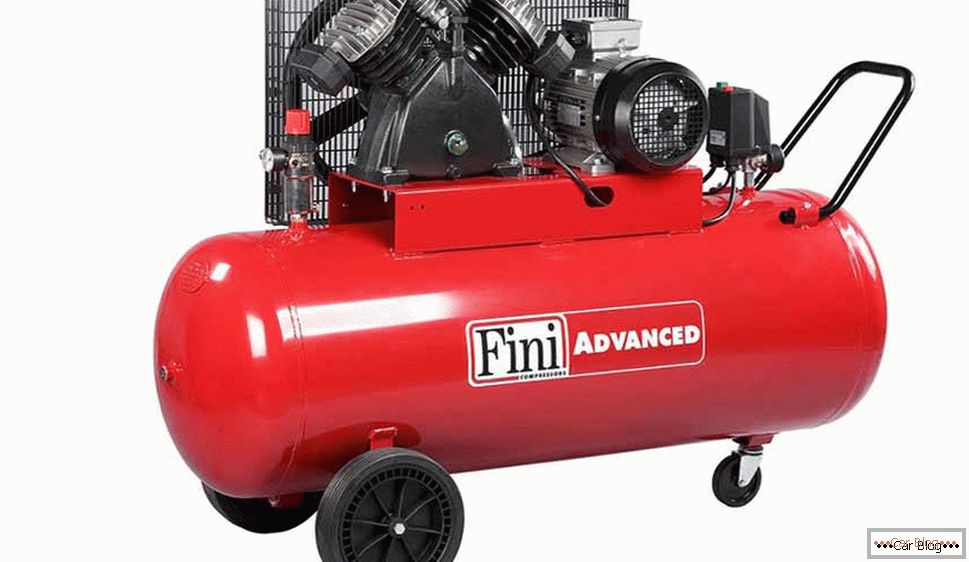
Features of the choice of compressor for painting a car.
Читать далее про то как правильно выбрать компрессор для покраски автомобиля-->
Purpose of automobile compressors
For any spray gun, the main component is a compressor - a device that provides air or other working gas mixture injection under pressure, which is necessary for high-quality spraying of paints and varnishes. We all remember the Soviet vacuum cleaners, which on one side sucked in dust, on the other - they injected air and were used as a source of compressed air for sprayers. Modern compressors have much greater efficiency, they are more powerful, more efficient, more reliable. There, however, there is a huge number of their varieties, which makes the task of choosing a compressor for painting a car non-trivial, requiring knowledge of the features of their design and the main criteria affecting the performance and cost of the device. In general, car painting is not the only area of use of compressor units in car maintenance and repair. The range of tasks solved with their help is extensive:
- work with tools that use pneumatic drive (wrenches, tire inflation devices);
- applying a layer of primer (pre-treatment surfaces of the car);
- agent for applying anticorrosive solutions;
- cleaning / purging of contaminated parts, assemblies and units;
- washing / polishing.
There are three classes of devices, depending on their intensity of use and degree of load.
Compressors for rare use
Affordable, but not designed for long-term use of the device - the choice of those who are engaged in painting body parts is relatively rare. What kind of compressor is needed to paint a car in a garage? The answer is quite simple: devices that provide performance in the range of 125 - 250 liters per minute. The specific value depends on the model of the spray gun, or rather, on its ability to consume the maximum amount of air. In this case, the working pressure of the compressor should not exceed 10 atmospheres, and the power should not lie within 1500 - 3000 watts. Such devices can operate for 15 - 20 minutes / hour. But even a low-power device should contain a filter for cleaning incoming air from various impurities contained in it, first of all, from dust and oils: when painting, the purity of the air used is an indicator critical to the quality of paint application. The presence of a refrigerant dryer used to clean the air flow from water vapor that is present in any compressed gases will also be useful.
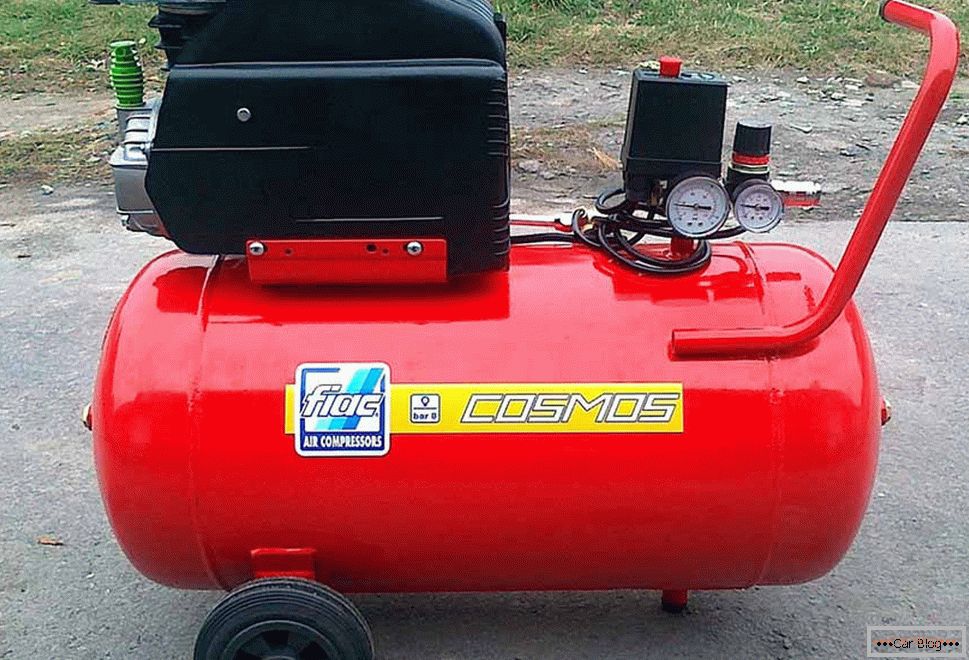
Compressors semi-professional level
For medium intensity painting work, a piston type belt compressor will be the optimal device. When choosing it, one should take into account such factors as the daily amount of work, and also whether it is supposed to use other tools with a pneumatic actuator (a grinding machine, for example, consumes a sufficiently large amount of air - about 500 - 600 liters per minute). The general rule is as follows: the compressor capacity should exceed the needs of the spray gun about one and a half times. Thus, if the technical characteristics of the spray gun - the consumption of about 300 liters of air per minute, then you need a compressor with a capacity of 450 - 600 liters per minute. A certain amount of power is also required, since in this case a longer operation of the device is ensured without frequent interruptions. Finally, the air volume that the spray gun can dispose of depends on the volume of the receiver. When carrying out paint work, ensuring non-stop spraying paint and varnish is a guarantee that the paint or varnish will not start to grasp before it gets onto the painted surface. In the latter case, paint defects in the form of sagging and gaps are inevitable.
Summarizing the above, it is possible to advise a compressor with a capacity of about 600 liters per minute for painting work in a small workshop, with a working pressure of about 16 bar with a receiver volume of 50 - 100 liters. With such equipment it is possible to paint both individual body parts and the entire car. Domestic compressors with a receiver with a volume of 40 - 50 liters and a capacity of up to 250 liters per minute to perform high-quality paint work with relatively frequent use will not be enough. Attention should be paid to the quality of the electrical wiring of the compressor power - for 10-15 kW weak wiring is a source of increased danger.
Professional compressors
For professional-grade tools and equipment, there are always high demands. No exception and devices for supplying compressed air used for the work of the painting equipment. When buying a compressor for painting cars, it’s better not to focus on cost, since it depends on many factors, not always related to the performance and reliability of the device, as well as the quality of work performed. The most appropriate requirements for professional use are piston-type compressors, equipped with an air dryer (this is the de facto standard for compressors of any level if increased demands are placed on the quality of the applied paint layer).
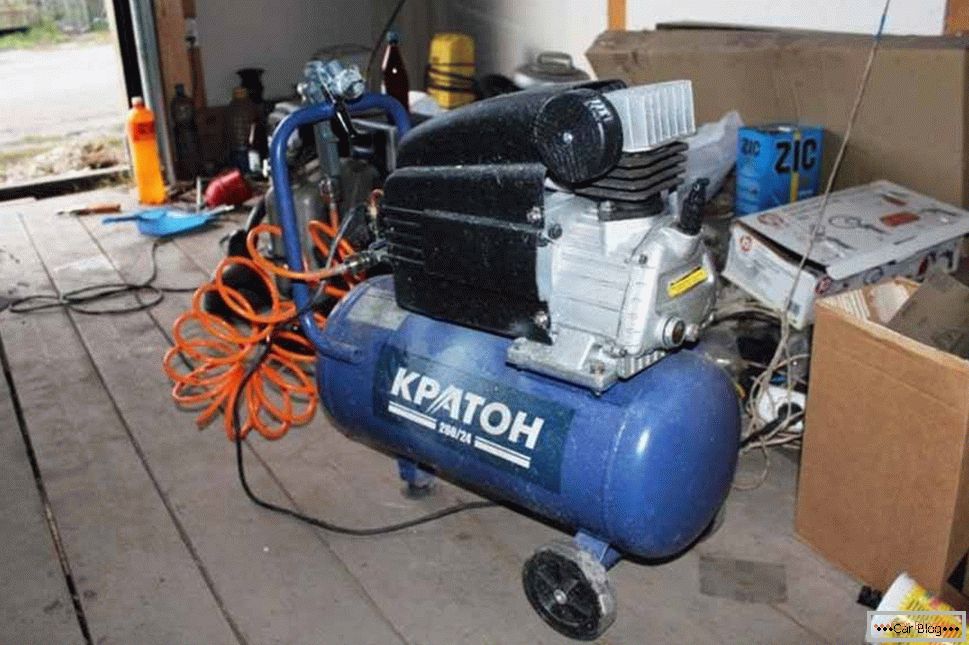
Good results can be achieved with the help of screw devices, characterized by average power. Such compressors are characterized by acceptable quality of the output air flow (low moisture and oil content), high reliability and acceptable energy consumption, they are easy to maintain and have a more compact size compared to piston analogues. If the production conditions assume a shortage of free space, screw compressors will come in handy. For service stations or companies specializing in car painting, compressor installations are recommended, which are mini-stations with a capacity of about 2.5 - 5.5 kW, with receiver volumes up to 900 liters and capacity up to 600 liters per minute. Completion of such units includes a compressor filter system and refrigeration dryers.
Compressor Types
A huge range of devices for air compression can create problems when choosing a compressor for painting a car, even with a specialist, not to mention those who are faced with this for the first time. This is not surprising, given that the classification of compressors involves taking into account the set of performance. We note the criteria in accordance with which we distinguish several types of such equipment:
- lubrication system (oil compressors and oil-free cooling technology);
- drive type (belt, coaxial);
- the number of stages of compression of the output air flow (single-stage, two-stage, multi-stage);
- air compression method (piston, screw compressors, membrane type devices);
- type of power unit (electric, gasoline, diesel);
- nature of performance (stationary, mobile).
When purchasing a compressor for painting a car, it is necessary to take into account, in addition to its technical characteristics (capacity, performance, receiver volume), and the above criteria.
Reciprocating Compressors
This is the most common type of tool for ensuring the supply of air under pressure, and regardless of the scope of use and the expected scope of work. Such a great popularity is due to an extensive set of advantages:
- extensive price range, from budget household models to modern compressor installations for professional use;
- relative simplicity of design, providing ease of installation and maintenance;
- unpretentious work (the ability to work in a large range of temperatures, in conditions of high dustiness).
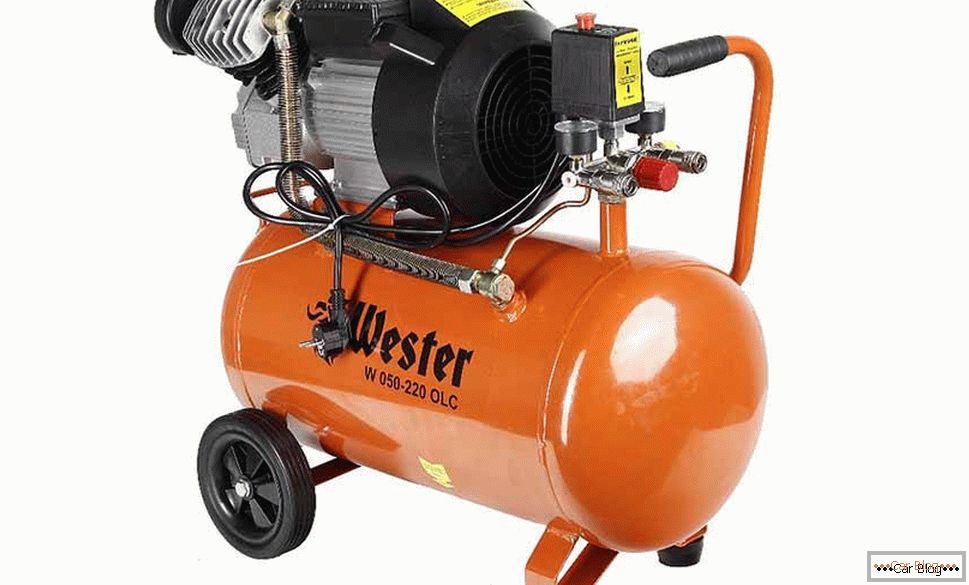
 Discounts for new cars! Profitable loan from 9.9% installments 0%
Discounts for new cars! Profitable loan from 9.9% installments 0%  adom.ru
adom.ru
A typical representative of the class of reciprocating compressors consists of the following components:
- piston mechanism (cylinder, rings, piston);
- impeller designed to cool the piston;
- gearbox equipped with a connector for connecting the hose and pressure gauge;
- filter for cleaning the input air flow;
- electric motor;
- control electronics;
- receiver (tank for compression of the gas mixture);
- condensate removal valve;
- on / off relay.
The key element of reciprocating air compressors is the engine (in most cases - electric), whose task is to ensure the operation of the piston group. The piston compresses the air entering the cylinder and transports it to the receiver. As the set pressure level is reached, the automation switches off the power unit, and when the pressure drops above the standard value, it turns on the motor again. As a rule, both parameters (minimum and maximum pressure) can be set manually. In case of failure of the control automatics, if the pressure threshold value is exceeded, an emergency valve is triggered, calculated on the indicator depending on the device model.
For lubrication of the piston group oil is used that is poured into the compressor crankcase. Diesel or gasoline units can be used as stand-alone devices. Timeless (coaxial) compressors have a combined head and motor shaft, which simplifies their design, but they are noisier and less reliable compared to axial (belt) counterparts. Oil-free compressors provide air that does not contain oils, but their performance is extremely low even for domestic purposes.
Screw compressors
Devices for supplying compressed air of screw type are a more modern type of compressors, the principle of operation of which is in many respects similar to the work of an ordinary meat grinder. In this case, the compression of the inlet air flow is carried out by joint rotation in opposite directions (and with unequal speed) of two screws, which ensure the creation of pressure and push the air into the receiver. If during the operation of a piston device the compression phase is replaced by the inlet phase, a continuous and uniform supply of compressed air is provided in the screw devices, which makes it possible to operate such tools for a long time (up to a day) without interruptions.
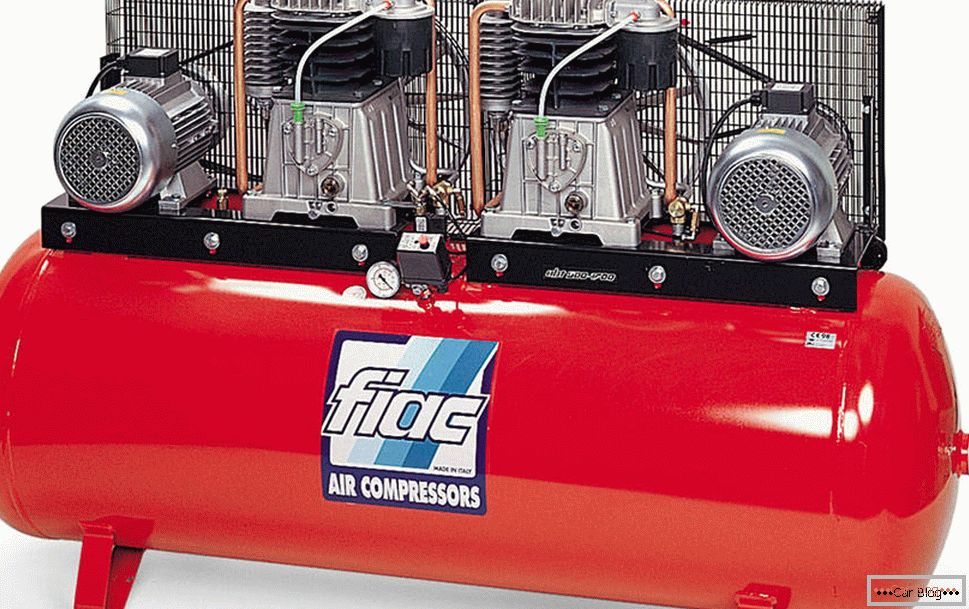
With the same performance indicators, screw compressors differ in smaller sizes and reduced (by 10 - 15 dB) noise level. In addition, they are characterized by a higher quality of the generated air flow at low operating costs. Particularly noteworthy is the durability of the screw supercharger - the wear of a pair of screws is significantly lower compared to the piston and crank mechanism. For this reason, the resource of such a compressor is much higher, and the cost of producing compressed air is lower (even with heavy loads, the life of the screw pair is about 8 years). However, the design of the screw compressor is much more complicated due to the use of a cooling / lubrication system of the circulating type, the presence of an automated control system, a whole complex of microfilters and a dryer of the inlet air flow of a refrigerator type.
All this makes this type of compressor devices more expensive, which is the main reason for their insufficient prevalence. Thus, the cost of a screw-type compressor compared to a piston counterpart with the same performance is 3-6 times more. If we proceed solely from considerations of recoupment (that is, resource), here, of course, there is an advantage on the side of screw devices. For enterprises equipped with powerful air ducts and having the need for constant air supply with a large continuous cycle of operation, such devices will be the best choice. For garage use, many of the benefits of screw compressors will be redundant, and the purchase itself may simply be unprofitable.
Stationary, mobile, autonomous devices
Most compressor units are stationary. This does not mean that they can not be moved to another place, but this operation may be too complicated and time consuming. Therefore, manufacturers have mastered the production of mobile models equipped with chassis and wheels. Such devices can often be found on large service stations or construction sites, provided there is an outlet. But in some cases this is not enough. The mobile use case is limited by the availability of power supply; therefore, for operation in field conditions, compressors are used, the power unit of which is a combustion engine running on gasoline or diesel fuel. The most common area of use for mobile compressor installations is construction sites, as well as emergency work when power supplies are unavailable. The absence of binding to the electrical network allows the use of diesel and petrol versions of compressors in the construction of bridges, laying of railway tracks and highways. Such a compressor for painting cars will also be suitable as a backup option for service stations in case of a prolonged power failure.
But for full autonomy you have to pay. One of the drawbacks of compressors powered by internal combustion engines is the need to use a heating device when operating in low temperatures. If such equipment must be used indoors, it must be adequately ventilated. When choosing an autonomous compressor for painting cars, one should take into account not only the higher cost of the device itself, but also the high level of fuel costs (compared to electricity). If the question is in the choice between diesel or petrol versions, the units operating on diesel fuel will be more complex and expensive, including operating costs. But diesel fuel itself will be slightly cheaper, and the engine will be safer and more productive. For the same reason, gasoline compressors should not be purchased with large volumes of paint work.

Design features of compressors
If a continuous cycle of painting work is assumed, then the purchase of equipment requiring the use of pauses in the work will be inappropriate. With small volumes, on the contrary, the purchase of an expensive screw compressor will be unjustified - here we must proceed from the resource of the purchased equipment and compare it with the expected load. Before choosing a compressor for painting a car, it is necessary to carefully study its characteristics. It should be borne in mind that usually the performance declared by the manufacturer is somewhat lower, since the figures put down are a calculated (theoretical) indicator based on data on the volume of the cylinder. In practice, the efficiency is less than 50%, that is, the energy loss will be very significant, and the actual performance will be at least half as much.
Security issues when working with compressor devices should also be given special attention, so you should choose the most reliable and high-quality equipment from well-known brands. The main instrument that allows you to visually monitor the amount of pressure generated in the receiver is a pressure gauge. If the control automatics fails, it is the pressure gauge that will be used by the emergency valve to turn off the engine. The pressure generated is not as important as the volumetric capacity. For car painting in garage conditions, the compressor power should be no more than 250 liters per minute with a receiver volume of up to 100 liters. In this case, as already noted, the performance of the compressor (again, the actual) should not exceed that of the spray gun.
Power supply
Most household compressors can operate on a conventional 220V two-phase network. But if in the place where the device is supposed to be used, there is a three-phase power supply, it is better to choose a compressor designed for a supply voltage of 380 V. The fact is that three-phase electrical equipment is less prone to voltage surges, which are a common phenomenon for the domestic power grid. If this is not possible, the voltage should be measured using a voltmeter. Monitoring should be performed three times a day - in the morning, in the afternoon and in the evening. With more or less stable measurements (no drops below 200 V), no additional measures need to be taken. But when the range of voltage surges is large (160 - 230 V), care should be taken to acquire a voltage regulator, otherwise the electric motor and electronics of the compressor will not last long. As practice shows, with an increase in pressure of 1 bar, the cost of electricity used increases by 6–8% (due to pressure loss in areas such as filters, desiccant, piping system). To reduce the cost of electricity, you should choose a compressor, the capacity of which will correspond to the nature of the work.
Receiver volume
Another important criterion when choosing a compressor is the volume of the working chamber for compressed air, which in this case is called the receiver. This indicator is important for piston-type devices operating in pulsed mode, indicating the air reserve available to the device. When choosing a compressor, be guided by such an indicator as non-stop operation time: if you use the device rarely and for painting individual body parts, then 15-20 minutes per hour will be quite enough. When organizing a continuous painting process, compressors with a screw mechanism should be selected that are able to work throughout the day.
Created pressure
Another indicator characterizing the operation of compressor units. True, it cannot be considered paramount, since for most compressors the level of injected pressure in the receiver is about the same and lies in a narrow range (7 - 12 bar). It can be changed in small limits by means of a special regulator. Since the compressor for painting a car deals with pressure, its operation is governed by the "Rules for the safe operation of pressure vessels".
Compressor capacity
This indicator is derived from power, but its value is important from the point of view of compliance with the gun, used in conjunction with the air blower. It should be noted that the spray guns can consume a sufficiently large amount of air (up to 500 - 600 liters per minute), therefore, the compressor performance should correspond to this indicator. To perform paint and varnish works, it is better to purchase a spray gun and a compressor at the same time - this will allow you to avoid unnecessary expenses. If the compressor fails to provide nominal performance for the airbrush, the quality of the painting will be unacceptably low. In other words, the performance characteristics of the compressor for painting auto and spray gun should be about the same.
Additional nuances
It is not enough one compressor for carrying out painting works. You will also need a hose, which is not included in the package, and the actual spray gun. For a budget-level compressor, you can use a twisted hose, which is also supplied with connecting fittings. As a spray gun, you can use inexpensive Italian / Chinese devices. You can also purchase ready-made kits that include both an airbrush, and connecting hoses with fittings, as well as additional tools (for example, a blowing gun designed for applying viscous paint and varnish compositions, or a tire inflation gun). With increasing demands on the quality of paint work, you need to be prepared, which will require more expensive equipment.
Consumables for compressors are filters and hoses. Straight hose is preferable to the spiral, because the behavior of the latter is often unpredictable, and they can get on the surface to be painted. Without timely replacement of filters, dust and other contaminants will be without obstacles in the paintwork composition, significantly deteriorating its quality (especially for metallized paints). In conclusion, we mention again that the compressor should be selected for painting cars in accordance with the performance characteristics of the device for applying paint.


